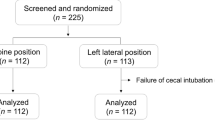Abstract
Background
Colonoscopy can detect both early intraluminal recurrence and metachronous neoplasia after colorectal cancer resection. Because colon length and location change after colorectal resection, factors affecting insertion time during colonoscopy also might be altered. The goal of this study was to examine whether colonoscope insertion time differs between left-sided resection and right-sided resection and to identify factors that impact the performance of colonoscopy after colorectal resection.
Methods
We included consecutive patients who underwent colonoscopy between November 2005 and November 2009 after colorectal resection for colorectal cancer. We classified surgical methods into left-sided resection (left hemicolectomy, low anterior resection, anterior resection, Hartman, and Mile’s operation) or right-sided resection (right hemicolectomy) and retrospectively evaluated the colonoscope insertion time. Moreover, we analyzed factors that might affect the insertion time.
Results
A total of 1,260 patients underwent colonoscopy after colorectal resection during the study period. Of these, 1,248 patients (771 men) who underwent complete colonoscopy were evaluated in this study. The colonoscopy completion rate was 99%, and the mean insertion time was 6.5 ± 5.1 min (median, 5 min; range, 0.3–61 min). Right-sided resection, female gender, poor quality of bowel preparation, lower endoscopist case volume, open laparotomy, and colonoscopy performed more than 1 year after colorectal resection were found to be independent factors associated with prolonged insertion time.
Conclusions
This large study identified six factors that affect colonoscope insertion time after colorectal resection. These findings have implications for the practice and teaching of colonoscopy after colorectal resection.
Similar content being viewed by others
References
Bresalier RS (2009) Early detection of and screening for colorectal neoplasia. Gut Liver 3:69–80
Garcia M, Jemal A, Ward EM et al (2007) Global cancer facts & figures 2007. American Cancer Society, Atlanta
Kim DH (2009) Risk factors of colorectal cancer. J Korean Soc Coloproctol 5:356–362
Neugut AI, Lautenbach E, Abi-Rached B et al (1996) Incidence of adenomas after curative resection for colorectal cancer. Am J Gastroenterol 91:2096–2098
Winawer SJ, Zauber AG, Ho MN et al (1993) Prevention of colorectal cancer by colonoscopic polypectomy. N Engl J Med 329:1977–1981
Nelson DB, McQuaid KR, Bond JH et al (2002) Procedural success and complications of large-scale screening colonoscopy. Gastrointest Endosc 55:307–314
Kim WH, Cho YJ, Park JY et al (2000) Factors affecting insertion time and patient discomfort during colonoscopy. Gastrointest Endosc 52:600–605
Church JM (1994) Complete colonoscopy: how often? And it not, why not? Am J Gastroenterol 89:556–560
Anderson JC, Messina CR, Cohn W et al (2001) Factors predictive of difficult colonoscopy. Gastrointest Endosc 54:558–562
Cirocco WC, Rusin LC (1995) Factors that predict incomplete colonoscopy. Dis Colon Rectum 38:964–968
Ginsberg GG (2003) Colonoscopy with the variable stiffness colonoscope. Gastrointest Endosc 58:579–584
Anderson JC, Jennifer D et al (2000) Factors that predict incomplete colonoscopy: thinner is not always better. Am J Gastroenterol 95:2784–2787
Lee SK, Kim TI, Shin SJ et al (2006) Impact of prior abdominal or pelvic surgery on colonoscopy outcomes. J Clin Gastroenterol 40:711–716
Todd NW, Robert E (2007) The difficult colonoscopy. Can J Gastroenterol 21:487–490
Messmann H, Barnert J (eds) (2006) Atlas of colonoscopy: techniques, diagnosis, interventional procedures. Thieme, Germany
Bernstein C, Thorn M, Monsees K et al (2005) A prospective study of factors that determine cecal intubation time at colonoscopy. Gastrointest Endosc 61:72–75
Arditi C, Gonvers JJ, Burnand B et al (2009) Appropriateness of colonoscopy in Europe (EPAGE II): surveillance after polypectomy and after resection of colorectal cancer. Endoscopy 41:209–217
Lautenbach E, Forde KA, Neugut AI (1994) Benefits of colonoscopic surveillance after curative resection of colorectal cancer. Ann Surg 220:206–211
Park DI, Kim HJ, Park JH et al (2007) Factors affecting abdominal pain during colonoscopy. Eur J Gastroenterol Hepatol 19:695–699
Streett SE (2007) Endoscopic colorectal cancer screening in women: can we do better? Gastrointest Endosc 65:1047–1049
Saunders BP, Fukumoto M, Halligan S et al (1996) Why is colonoscopy more difficult in women? Gastrointest Endosc 43:124–126
Sadahiro S, Ohmura T, Yamada Y et al (1992) Analysis of length and surface area of each segment of the large intestine according to age, sex and physique. Surg Radiol Anat 14:251–257
Waye JD (2000) Completing colonoscopy. Am J Gastroenterol 95:2681–2682
Zuber-Jerger I, Endlicher E, Gelbmann CM (2008) Factors affecting cecal and ileal intubation time in colonoscopy. Med Klin (Munich) 103:477–481
Liakakos T, Thomakos N, Fine PM et al (2001) Peritoneal adhesions: etiology, pathophysiology, and clinical significance. Recent advances in prevention and management. Dig Surg 18:260–273
Levrant SG, Bieber EJ, Barnes RB (1997) Anterior abdominal wall adhesions after laparotomy or laparoscopy. J Am Assoc Gynecol Laparosc 4:353–356
Al-Sunaidi M, Tulandi T (2006) Adhesion-related bowel obstruction after hysterectomy for benign conditions. Obstet Gynecol 108:1162
Ellis H (1997) The clinical significance of adhesions: focus on intestinal obstruction. Eur J Surg Suppl 577:5–9
Parker MC, Wilson MS, Menzies D et al (2004) Colorectal surgery: the risk and burden of adhesion-related complications. Colorectal Dis 6:506–511
Disclosures
Hui Won Jang, Jae Hee Cheon, Chung Mo Nam, Chang Mo Moon, Jin Ha Lee, Soung Min Jeon, Jae Jun Park, Tae Il Kim, and Won Ho Kim have no conflicts of interest or financial ties to disclose.
Author information
Authors and Affiliations
Corresponding author
Rights and permissions
About this article
Cite this article
Jang, H.W., Cheon, J.H., Nam, C.M. et al. Factors affecting insertion time for colonoscopy performed under intramuscular analgesia in patients with history of colorectal resection. Surg Endosc 25, 2316–2322 (2011). https://doi.org/10.1007/s00464-010-1555-3
Received:
Accepted:
Published:
Issue Date:
DOI: https://doi.org/10.1007/s00464-010-1555-3




